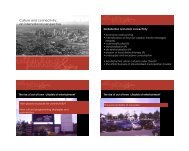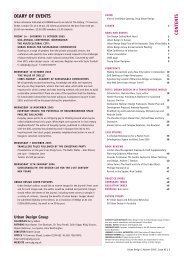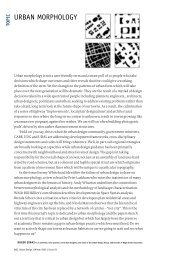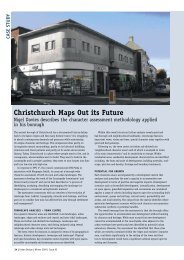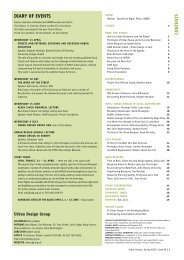topic - urban-design-group.org.uk
topic - urban-design-group.org.uk
topic - urban-design-group.org.uk
You also want an ePaper? Increase the reach of your titles
YUMPU automatically turns print PDFs into web optimized ePapers that Google loves.
NEWS AND EVENTS<br />
Putting Urbanism at the Heart of the Agenda<br />
RIBA Conference 15 July 2004<br />
Over 100 people attended a by-invitation<br />
meeting called by the RIBA’s president<br />
and John Thompson, chair of the<br />
RIBA Urbanism and Planning Group,<br />
to discuss what <strong>urban</strong>ism is and what<br />
actions can be taken to achieve ‘good’<br />
<strong>urban</strong>ism. The first hour was spent<br />
trying to tease out what <strong>urban</strong>ism is,<br />
by asking attendants to write their own<br />
definition on post-it notes. The core<br />
of the afternoon were nine parallel<br />
workshops on <strong>topic</strong>s ranging from RIBA<br />
Awards for Urbanism, through Urbanism<br />
and Sustainability, Delivering Urbanism<br />
to Skills for Urbanism. The teams were<br />
asked to suggest actions that could be<br />
implemented in the immediate future<br />
and to identify how and by whom this<br />
would happen. After a couple of hours<br />
of debate each <strong>group</strong> reported back to<br />
a plenary session and a series of good<br />
ideas was put forward.<br />
Undoubtedly, the fact that the RIBA<br />
is taking an interest in <strong>urban</strong>ism, and<br />
by implication in <strong>urban</strong> <strong>design</strong>, is to<br />
be welcomed. As was mentioned at the<br />
meeting, for too long architects have<br />
been concerned with the site and not<br />
with its context. This was one of the<br />
reasons for the creation of the Urban<br />
Design Group over 25 years ago, and it is<br />
good to see the RIBA joining us. On the<br />
other hand, the fact that so many people<br />
in the room did not seem to know what<br />
UDAL was, or to realise that the issues<br />
on the agenda had been discussed over<br />
and over for years by the UDG and UDAL,<br />
is worrying. It felt a bit like reinventing<br />
the wheel without building it. There<br />
were not many ideas that had not been<br />
mentioned in this magazine or at UDG<br />
meetings of one kind or another. And<br />
why weren’t more people in the room<br />
members of the UDG?<br />
A related question is why is the<br />
RIBA suddenly interested in <strong>urban</strong>ism<br />
when it has not played a very active role<br />
within UDAL? Could it be that the job<br />
market for architects is changing and<br />
<strong>urban</strong> <strong>design</strong> skills are becoming more<br />
widely needed? Could it also be that<br />
the RIBA acknowledges the changes in<br />
the agenda and does not want to lose<br />
its controlling role? Perhaps it does not<br />
matter if more people come to realise<br />
the importance of <strong>urban</strong> <strong>design</strong> and are<br />
willing to promote higher quality places.<br />
The actions that the RIBA takes to follow<br />
this first meeting will indicate whether<br />
or not it is all worthwhile. We shall keep<br />
an eye on this.<br />
Sebastian Loew<br />
Study Tour of the Saxon Towns of Transylvania<br />
15-23 May 2004<br />
Above Sibiu Town Hall separates two market<br />
squares<br />
Opposite page top Sighisoara clock tower<br />
Opposite page bottom Fortified churches<br />
On the 15th May 2004, 30 UDG members,<br />
spouses and friends set off by air for<br />
Bucharest, where we were joined by<br />
six French colleagues. Our goal was<br />
Transylvania, where we were to look<br />
at the German heritage of town and<br />
village building. But first we were to<br />
make the acquaintance of Bucharest,<br />
a vast and sprawling metropolis whose<br />
character can only be discovered by<br />
peeling away the chronological layers<br />
of which it is made up. In this we were<br />
greatly assisted by Mariana Celac, former<br />
president of the Romanian Union of<br />
Architects, who gave us an illustrated<br />
talk and led us on a coach tour.<br />
Bucharest was the principal city of<br />
Wallachia which until 1880 was part,<br />
although a fairly autonomous one, of<br />
the Ottoman Empire. Consequently, the<br />
surviving historic areas are characterised<br />
by Orthodox churches and low-key,<br />
Turkish-style houses, but no mosques.<br />
After 1918 Romania doubled in size,<br />
becoming a relatively wealthy country<br />
with a sizeable <strong>urban</strong> middle class,<br />
and so the capital was replanned with<br />
substantial modernist and neo-classical<br />
buildings fronting new avenues carved<br />
through the older quarters. It was<br />
this period of expansion that inspired<br />
Ceausescu to leave his own grandiose<br />
mark and wreak destruction, though not<br />
on a scale as great as one had been led<br />
to believe. Today regeneration is taking<br />
place in a patchy way largely following<br />
commercial imperatives. Altogether a<br />
complex and fascinating city.<br />
We then set off by train for<br />
Transylvania, which could have been<br />
4 | Urban Design | Autumn 2004 | Issue 92



